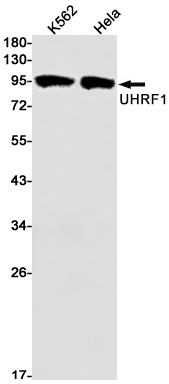
| WB | 咨询技术 | Human,Mouse,Rat |
| IF | 1/20 | Human,Mouse,Rat |
| IHC | 咨询技术 | Human,Mouse,Rat |
| ICC | 技术咨询 | Human,Mouse,Rat |
| FCM | 咨询技术 | Human,Mouse,Rat |
| Elisa | 咨询技术 | Human,Mouse,Rat |
| Aliases | Np95; hNP95; ICBP90; RNF106 |
| Entrez GeneID | 29128 |
| WB Predicted band size | Calculated MW: 90 kDa; Observed MW: 97 kDa |
| Host/Isotype | Rabbit IgG |
| Antibody Type | Primary antibody |
| Storage | Store at 4°C short term. Aliquot and store at -20°C long term. Avoid freeze/thaw cycles. |
| Species Reactivity | Human |
| Immunogen | Recombinant protein of human UHRF1 |
| Formulation | Purified antibody in TBS with 0.05% sodium azide,0.05%BSA and 50% glycerol. |
+ +
以下是3-4篇关于UHRF1抗体的参考文献及简要摘要:
---
1. **文献名称**: *UHRF1 overexpression drives DNA hypomethylation and hepatocellular carcinoma*
**作者**: Mudbhary R, et al.
**摘要**: 该研究通过免疫组化(IHC)和Western blot(WB)分析,发现UHRF1在肝细胞癌(HCC)中过表达,并与DNA低甲基化及患者不良预后相关。研究采用特异性UHRF1抗体验证了其在肿瘤组织中的异常表达及表观遗传调控作用。
---
2. **文献名称**: *UHRF1 links histone H3K9 methylation to DNA methylation through DNMT1 interaction*
**作者**: Bostick M, et al.
**摘要**: 研究通过染色质免疫沉淀(ChIP)和WB实验,利用UHRF1抗体揭示其通过结合DNMT1维持DNA甲基化的分子机制,证实UHRF1作为桥梁分子连接组蛋白H3K9甲基化与DNA甲基化,影响表观遗传沉默。
---
3. **文献名称**: *UHRF1 as a novel diagnostic and therapeutic target in cancer*
**作者**: Ashraf W, et al.
**摘要**: 该综述总结了UHRF1在多种癌症中的异常表达及其临床意义,强调通过特异性抗体检测UHRF1可作为癌症诊断标志物,并探讨靶向UHRF1的潜在治疗策略。
---
4. **文献名称**: *UHRF1 depletion and HDAC inhibition synergistically induce apoptosis in breast cancer*
**作者**: Alhosin M, et al.
**摘要**: 研究通过siRNA敲低UHRF1并结合组蛋白去乙酰化酶抑制剂处理,利用UHRF1抗体检测蛋白表达变化,发现UHRF1抑制可增强乳腺癌细胞对表观遗传药物的敏感性,提示其作为联合治疗靶点的潜力。
---
这些文献涵盖了UHRF1抗体在基础机制研究(如DNA甲基化调控)及临床转化(如癌症诊断和治疗)中的应用场景,涉及实验技术包括WB、IHC和ChIP等。
UHRF1 (Ubiquitin-like with PHD and RING Finger domains 1) is a multifunctional epigenetic regulator critical for maintaining DNA methylation and histone modifications during DNA replication and repair. It acts as a bridging molecule between DNA methyltransferase 1 (DNMT1) and hemimethylated DNA, ensuring faithful propagation of methylation patterns across cell divisions. UHRF1 also participates in heterochromatin formation, cell cycle progression, and genomic stability by ubiquitinating histone H3. Dysregulation of UHRF1 is linked to cancer, where its overexpression correlates with poor prognosis, tumor proliferation, and epigenetic silencing of tumor suppressor genes.
UHRF1 antibodies are essential tools for studying its expression, localization, and interactions in various biological contexts. These antibodies are widely used in techniques like Western blotting, immunohistochemistry (IHC), immunoprecipitation (IP), and immunofluorescence (IF) to investigate UHRF1's roles in development, disease, and epigenetic mechanisms. High-quality UHRF1 antibodies specifically recognize distinct domains (e.g., ubiquitin-like, PHD, or RING finger) or post-translational modifications, enabling researchers to dissect its functional diversity. Challenges in antibody development include ensuring specificity due to structural similarities with other ubiquitin-related proteins and cross-reactivity across species. Commercially available antibodies are often validated in human, mouse, or rat models, supporting translational research in cancer, neurodegeneration, and aging. As UHRF1 emerges as a potential therapeutic target, its antibodies remain pivotal for biomarker discovery and mechanistic studies.
×